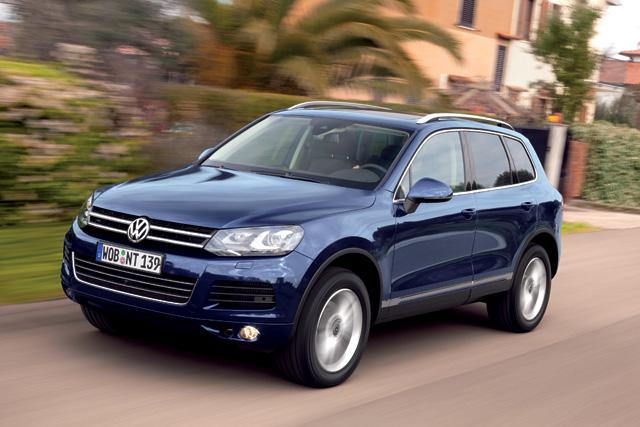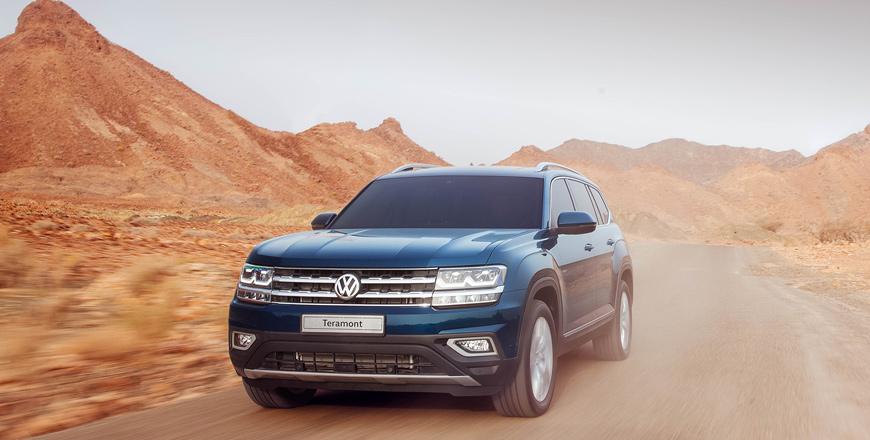You are here
Tasteful Touareg
By Ghaith Madadha - Mar 03,2014 - Last updated at Mar 03,2014

AMMAN — The classiest of the wider Volkswagen group’s big SUVs sits lower in the pecking order than a flashy Porsche Cayenne or Audi Q7, but instead exudes a restrained and understated but elegantly conservative sensibility.
Introduced in 2011, the second generation Touareg makes a better case for itself as a sensible and middle class large family SUV, which combine on-road refinement and reassuring dynamics with spacious size, tasteful cabin and ride comfort.
And with the optional Terrain Tech package, as tested, the Touareg gets low gear ratios and locking differentials to significantly improve its off-road abilities.
Classy conservatism
A complete but evolutionary redesign, the second generation Touareg is not a radical departure since the original or from the rest of the Volkswagen range, but features a larger bumper, more prominent wheel-arches and a tidier fascia design.
The biggest compliment to the Touareg’s tight, clear and uncomplicated design is that it looks smaller and better packaged than its actual size, and resembles an overgrown Golf.
Benefiting from the slightly moodier and more assertive design language since the 2008 Scirocco, the wider, lower and longer Touareg looks subtly sportier and more resolved, and features improved cabin space and aerodynamics.
Well fitted and finished, the Touareg has a typically classy Volkswagen feel to it, with symmetric, clear and user-friendly layouts, prominent soft textures and clean design lines and curves, while hard plastics are more discretely positioned.
Seating is comfortable and adjustable while the thick steering wheel falls nicely to hand and large round instruments are clear.
Efficient and elegantly uncomplicated, the Touareg’s airy cabin looks best in dark tones.
Passenger space is generous, with a lengthened wheelbase improving rear legroom, while cargo volume extends from 580 litres to 1,642 litres when the rear seats are folded.
Smooth operator
A long-standing Volkswagen engine, the Touareg’s entry-level 3.6-litre naturally aspirated direct injection petrol V6 sits below the European market three-litre supercharged V6 and the range-topping 4.2-litre V8.
Smooth and well up to the job of motivating the Touareg’s 2,136 kilogramme mass, the 3.6 V6 is mated to an eight-speed auto gearbox, which with aggressive first and second gears allows for reasonably swift 7.8-second 0-100km acceleration.
The eight-speed’s two overdrive gears and a wider number of ratios allow for better optimisation of output, restrained 10.2l/100km combined cycle fuel efficiency and smooth, low rev and quiet motorway refinement.
Developing 276BHP at 6,200rpm and 265lb/ft torque throughout a 3,000-4,000rpm mid-range, the Touareg’s naturally-aspirated V6 is progressive in delivery, but with usefully healthy mid-range flexibility that is aided by its eight-speed gearbox when quick overtaking is required.
Hustling the 3.6 Touareg at a brisk pace along winding roads is also done best by manually working the gearbox to hold revs longer.
As quick as an SUV really needs to be, the Touareg’s respectable performance always feels refined and timely rather than aggressive or abundant, especially so because of its 2.1-tonne weight and extensive cabin insulation.
Reassuring ride
A refined car-like SUV with unibody construction and independent suspension all around, the Volkswagen Touareg rides smoothly and comfortable soaks up bumps, cracks, ripples and imperfections, despite riding on relatively low profile 265/50R19 tyres.
However, the Touareg’s comfort and suppleness by no means suggests sloppy or wallowing handling, as is a reassuring and composed through corners, with good body control and only light lean.
With precise and light but somewhat clinical steering, the Touareg is easy to manoeuvre and turns in tidily, stays true to cornering lines through curves and grips hard.
Walking a carefully balanced middle road between comfort and dynamics, the Touareg has a distinct sense of solidity and confidence, with its four-wheel-drive clawing at the tarmac when one puts power down, while its long wheelbase and good body control lend it terrific road holding through corners.
Being a large German car designed for regular Autobahn duties, the Touareg naturally feels poised and rock solidly planted on the highway, where it is insulated and refined but with a subtle reassuring firmness and excellent directional stability. Light steering and good visibility also make town driving easy.
Off-road ability
Classy, composed and comfortable the Volkswagen Touareg may be best known for its smooth on-road driving, but it can also well handle itself off-road.
This is especially so when fitted with the optional Terrain Tech package, which crucially off-road hardware like a low ration gearbox transfer, to allow one to reduce speed to a crawling pace while exploiting the engine’s maximum power output, whether driving hard and fast through sand or on a more technical course or steep incline.
Terrain Tech also brings locking centre and rear differentials to allow wheels to prevent slippage and keep turning in sync.
Diff locks help get the Touareg out of low traction situations, while optional air suspension raises ride height by 300mm to allow 580mm water wading, 30° approach and departure and 27° break-over angles for traversing obstacles.
Taking on choppy dirt tracks and sand well during it regional launch test drive, the Touareg also impressed in how it climbed steep sand inclines, through which one had to keep in first or second gear with engine revs high.
The Touareg also features a hill descent control, which utilises ABS, traction and stability controls to steady, smooth and safe low traction descents.
SPECIFICATIONS
Engine: 3.6-litre, cast iron block / aluminium head in-line V6-cylinders
Bore x stroke: 89 x 96.4mm
Valve-train: 24-valve DOHC, direct injection
Gearbox: 8-speed automatic,
Ratios: 1st 4.85; 2nd 2.84; 3rd 1.86; 4th 1.44; 5th 1.22; 6th 1.0; 7th 0.82; 8th 0.67
Reverse / final drive: 3.83 / 3.7
Drivel-line: four-wheel drive, low gear transfer, locking centre & rear differentials
Power, BHP (PS) [kW]: 276 (280) [206] @ 6,200rpm
Torque, lb/ft (Nm): 265 (360) @ 3,000-4,000rpm
0-80 km/h: 5.5-seconds
0-100 km/h: 7.8-seconds
Maximum speed: 228km/h
Fuel consumption, combined: 12.2-litres/100km
CO2 emissions, combined: 239g/km
Fuel capacity: 100-litres
Length: 4,795mm
Width: 1,940mm
Height (w/ roof rails): 1,709 (1,732)mm
Wheelbase: 2,893mm
Tread width, F/R: 1,656 / 1,676 mm
Ground clearance, minimum: 159mm
Approach / departure / break-over angles: 30° / 30° / 27°
Hill climbing angle: 45°
Side slope: 35°
Water wading: 580mm
Curb weight: 2,136kg
Turning circle: 11.9-metres
Head room, front (w/ sunroof): 1,014 (1,005)mm
Head room, rear (w/ sunroof): 989 (984)mm
Interior width, F/R: 1,549 / 1,511mm
Luggage capacity, min / max: 580 / 1,642-litres
Payload: 583kg
Suspension, F/R Upper & lower control arms / multi-link
Steering: Power-assisted rack & pinion
Tyres: 265/50R19
Related Articles
Filling the role of luxury SUV in a Volkswagen line-up that includes a larger, more affordable, but less sophisticated Teramont SUV, the cur
A perfectly competent, capable all-rounder, and more accessible up-market offering in the then newly burgeoning SUV market when first introd
Designed as a 7-seater from the outset, the Volkswagen Teramont is the German brand’s large SUV successor to the Touareg in certain markets


















